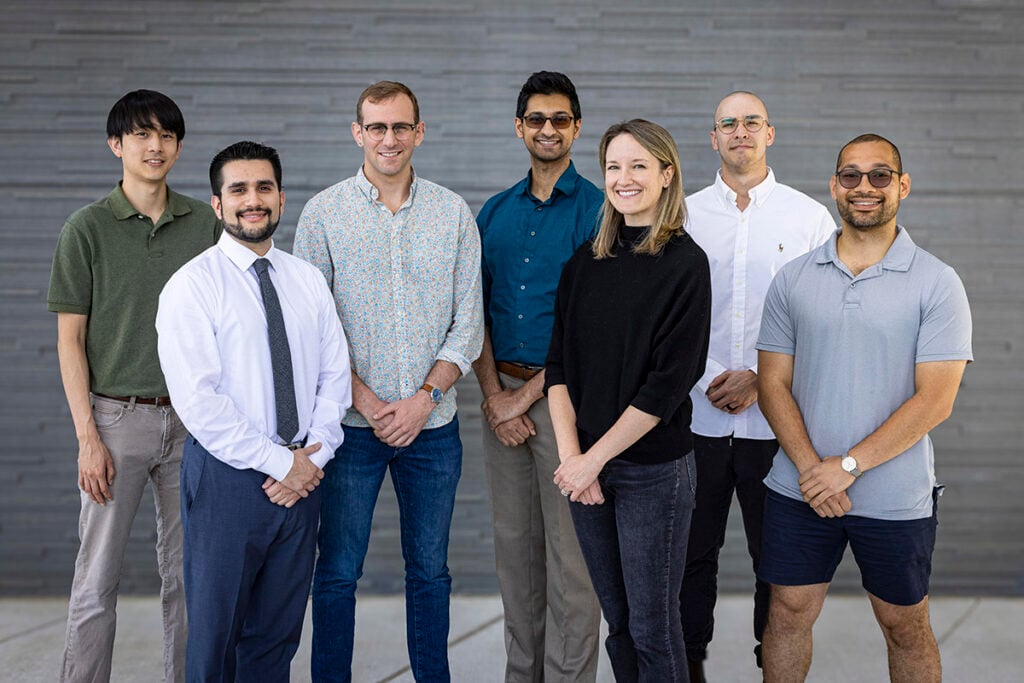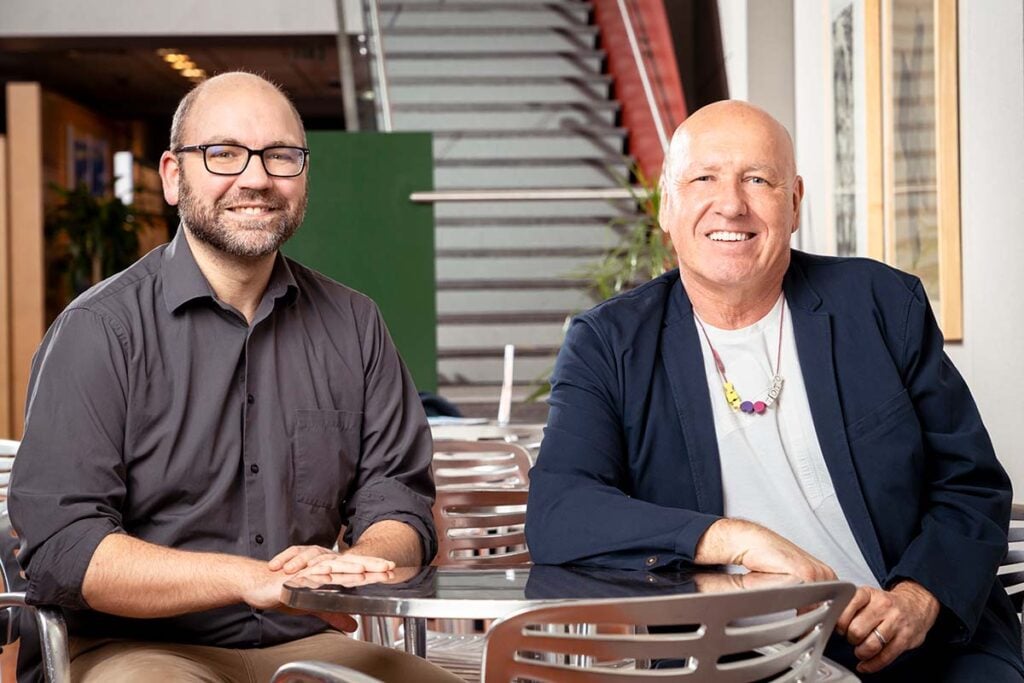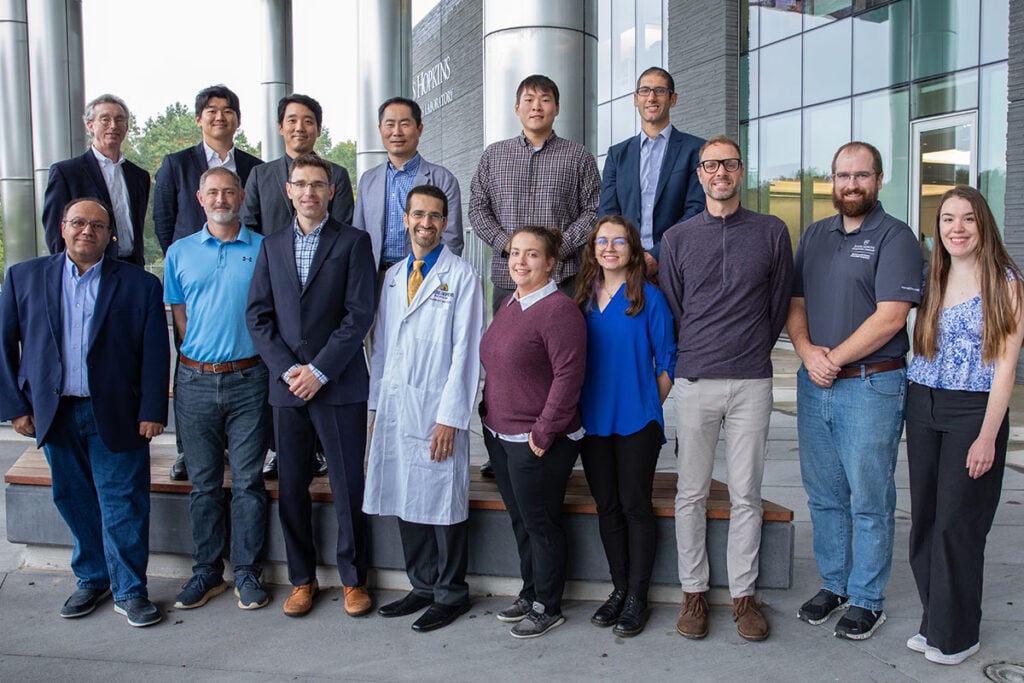Johns Hopkins Teams Poised to Create Transformative Technologies
Written by Gabrielle Delisle-Ballard on October 31, 2024
By Ajai Raj
Cheap and plentiful hydrogen harvested from water. Lightning-fast biocomputers running on brain-like substrates. Widely available noninvasive brain scans for early detection of neurological disease. A visual prosthesis in the form of glasses that returns sight to people with previously incurable vision loss. These are the four boundary-pushing proposals funded in this year’s cycle of the Johns Hopkins University’s SURPASS initiative.
Launched in 2022, the SURPASS program — a joint effort between the university’s Whiting School of Engineering (WSE) in Baltimore and the Applied Physics Laboratory (APL) in Laurel, Maryland — aims to solve some of the world’s most pressing problems and overcome seemingly insurmountable challenges.
“The four final SURPASS proposal teams demonstrated remarkable promise to take their research to the next level, and have been awarded funding to help realize this potential,” said Ed Schlesinger, dean of WSE. “These proposals have the potential to lead to even larger translational efforts that have the potential to bring enormous benefit to people and society.”
“The projects selected for this cycle are focused on bold new technologies,” said APL Director Ralph Semmel. “The innovative partnerships between APL and the Whiting School are inspiring both for our researchers and for the promise they hold to improve the lives of people around the world.”
The program’s second call for proposals garnered 36 white paper submissions, five of which were selected to be developed into full proposals. Ultimately, SURPASS awarded funding to four teams, providing a total of approximately $3.75 million across the selected teams for 18 months of performance. Three of these teams are continuing work from the program’s first cycle, based on the progress they’ve already made and the high potential of their work.
Each proposal is led by two principal investigators (PIs), one from APL and the other from WSE. SURPASS leverages WSE’s and APL’s technical strengths and research and development communities, supporting cross-divisional teams dedicated to using innovative, multidisciplinary approaches. The program pulls in experts from across JHU, including the university’s School of Medicine (SOM) and the Bloomberg School of Public Health (BSPH). Additionally, SURPASS partners with APL’s Research and Exploratory Development Mission Area, which serves as a transition agent, assisting with exposing SURPASS technologies more broadly.
Here are the four teams selected to receive funding.

The AI-Driven Discovery of High-Entropy H2 Generators team, from left: Victor Leon (APL), Corey Oses (co-principal investigator, WSE), Avi Bregman (co-principal investigator, APL), Karun Kumar (APL), Leslie Hamilton (APL), Kenneth Kane (APL) and A. Shoji Hall (WSE). Not pictured: Morgan Trexler (APL). Credit: Johns Hopkins APL/Ed Whitman
ADD-H2: AI-Driven Discovery of High-Entropy H2 Generators

The Cerebro team, from left: Mark Foster (WSE), Amy Foster (co-principal investigator, WSE), Jeremiah Watson (APL), Nicholas Pavlopoulos (co-principal investigator, APL), Griffin Milsap (APL), Nathan Rafisiman (APL), Ruidong Xue (WSE) and Jackson Pittman (APL). Not pictured: Jacob Khurgin (WSE), Konstantinos Gerasopoulos (APL) and Elisabeth Marsh (SOM).
Credit: Johns Hopkins APL/Craig Weiman
Cerebro: Enabling the Next Step of Human Evolution
Team: Co-PI Amy Foster (WSE), Co-PI Nicholas G. Pavlopoulos (APL), Jacob Khurgin (WSE), Mark Foster (WSE), Jeremiah Wathen (APL), Griffin Milsap (APL), Konstantinos Gerasopoulos (APL), Elisabeth Marsh (SOM)
Advances in brain imaging have made it possible to predict strokes and brain tumors and to identify conditions such as Alzheimer’s disease and dementia earlier than conventional diagnostic methods. Neuroimaging is also proving to be a valuable research tool in studying autism spectrum disorders and has enabled therapeutic and human enhancement concepts, such as using the power of thought to operate prostheses and remote machinery.
Unfortunately, the actual benefits of neuroimaging are currently limited because of the lack of noninvasive methods for monitoring brain activity that are also portable, wearable, sensitive, high resolution and — critically — inexpensive. Creating such a method is the mission of the Cerebro team.
With their first round of SURPASS funding, the team made critical strides toward its goal by demonstrating that it’s possible to convert weak magnetic fields like those generated by brain activity into optical signals. This in turn makes it possible to leverage existing technology to read those signals.
“In the past year, we’ve developed novel materials that change how light passes through them when you put them in a magnetic field and that can be easily integrated into chips,” said Nicholas Pavlopoulos, Cerebro co-PI at APL. “We’ve also built surrogate systems to test these materials by using photonic integrated circuits.”
In this round of SURPASS, the team hopes to demonstrate that its materials can measure biologically produced magnetic fields and, if they achieve that in their intended time frame and sensor format, compare their sensors to state-of-the-art brain monitoring equipment.
Ultimately, the Cerebro team is motivated in this ambitious effort by the lifesaving promise this technology holds.
“It’s 2024, and early diagnostics have completely changed the field for so many diseases, including some very scary cancers,” Pavlopoulos said. “If we can figure out how to get the necessary technology into the form of a microchip, we envision brain scans can become a routine part of your yearly physical, something you can get in an urgent care clinic.”

Organoid Intelligence principal investigators Erik C. Johnson (APL) and Thomas Hartung (WSE).
Credit: Johns Hopkins APL/Craig Weiman
Organoid Intelligence: Synthetic Biological AI
Team: Co-PI Erik C. Johnson (APL), Co-PI Thomas Hartung (WSE and BSPH), Lomax Boyd (BSPH), Brian Caffo (BSPH), David Gracias (WSE), Erin Hahn (APL), Tim Harris (WSE), Jeffrey Kahn (BSPH), Bart Paulhamus (APL), Lena Smirnova (WSE/BSPH), Francesco Tenore (APL), Brock Wester (APL), Mike Wolmetz (APL)
Our understanding of biological intelligence is still in its infancy, and the same might be said of AI. Integrating both into a single system holds the promise to dramatically improve our understanding of each and potentially produce a quantum leap in computing as we know it.
The Organoid Intelligence (OI) team is pioneering the use of brain organoids — 3D cell culture models that are grown from adult human stem cells and mimic certain structural and functional properties of specific regions of the brain. Doing this will allow the team to gain insight into the emergence of intelligence in biological neural networks.
The OI team has made considerable progress with its first round of SURPASS funding. The team has created a prototype system for OI experiments, new methods for electrically stimulating and recording activity in organoids, innovative microfluidic devices to maintain the health and stability of the cell cultures, and novel machine learning and AI tasks to test these systems.
All of this has laid the groundwork for an even more impressive showing in the second round.
“The work we did in the first round of SURPASS has really set us up to advance discovery by growing larger organoids and developing more testing modalities and tasks to gain deeper insight into how these systems work,” said Thomas Hartung, co-PI at WSE.
“In the new cycle, I would like to increase the complexity of the model by introducing more regions of the brain involved in learning and reward processing,” said Lena Smirnova, a member of the WSE OI team.
“We’ve done some experiments to help us understand the mechanisms of long-term learning in these brain organoids — how the synapses change their connectivity strength in response to performing a task, which is one of the basic mechanisms of learning,” said Erik C. Johnson, the OI team’s co-PI at APL. “We’re also developing new interfaces and microfluidic systems that can work with the complex 3D cell cultures we’re creating and overcome the limitations of commercially available 2D systems.”
Beyond the scope of the second stage of SURPASS, he added, the team will also formalize protocols for ensuring ethical oversight of this work.

The Photoacoustic Retinal Prosthesis team, from top left: James Spicer (WSE), Hyunwoo Song (WSE), Jeeun Kang (WSE), Jin Kang (WSE), Wayne Rogers (WSE), David Shrekenhamer (APL), Emad Boctor (co-principal investigator, WSE), Luke Currano (APL), Seth Billings (co-principal investigator, APL), Yannis Paulus (SOM), Jacalynn Sharp (APL), Alexandra Patterson (WSE), Chad Weiler (APL), Christopher Stiles (APL), Erika Rashka (APL). Not pictured: Maomao Chen (SOM), Bree Christie (APL), George Coles (APL), Peter Gehlbach (SOM, WSE), Thomas Johnson (SOM), Dominique Meyer (WSE), Van Phuc Nguyen (SOM), Francesco Tenore (APL), Ji Yi (WSE), Don Zack (SOM) and Mi Zheng (SOM).
Credit: Johns Hopkins APL/Justin Gladden
Photoacoustic Retinal Prosthesis: A New Paradigm for Prosthetic Vision
Team: Co-PI Emad Boctor (WSE), Co-PI Seth Billings (APL), Maomao Chen (SOM), Bree Christie (APL), George Coles (APL), Luke Currano (APL), Peter Gehlbach (SOM, WSE), Jeeun Kang (WSE), Jin Kang (WSE), Casey Keuthan (SOM), Dominique Meyer (WSE), Van Phuc Nguyen (SOM), Alexandra Patterson (WSE), Yannis Paulus (SOM), Erika Rashka (APL), Wayne Rodgers (WSE), Jacalynn Sharp (APL), David Shrekenhamer (APL), Hyunwoo Song (WSE), James Spicer (WSE), Christopher Stiles (APL), Francesco Tenore (APL), Chad Weiler (APL), Ji Yi (WSE), Don Zack (SOM), Mi Zheng (SOM)
Around 3 million Americans today suffer from irreversible degenerative vision disorders — a figure that is set to double by 2050. The team behind Photoacoustic Retinal Prosthesis hopes to provide a viable treatment option for individuals suffering from blindness or severe vision loss due to incurable disorders of the outer retina.
To do that, they’re harnessing the power of the photoacoustic effect, a physical phenomenon used in a variety of scientific applications whereby a material absorbs light, heats, and rapidly expands, generating pressure waves that then propagate as ultrasound. The team’s patented approach — known as photoacoustic retinal stimulation, or PARS — involves using a focused nanosecond pulsed laser to irradiate an implant material to produce ultrasound waves. These then stimulate activity within the residual neurons of the inner retina that are responsible for vision. In contrast to existing vision-restoration devices, which require implanting an invasive, active device onto the retina, this approach uses a passive implant that would be stimulated by a wearable device in an eyeglasses form factor.
In its first phase of research under last year’s SURPASS program, the Photoacoustic Retinal Prosthesis team developed a prototype test device and completed proof-of-concept experiments demonstrating its ability to successfully stimulate activity in retinal neurons.
As the researchers continue their work this year, they’re focused on maturing their technology to improve performance and expand the domain of retinal disorders that could be alleviated with the device, continuing biological studies to further characterize the safety and efficacy of the prototype and optimizing their approach through further experiments.
“No one person or small team can have all of the knowledge and experience that’s required to accomplish something like this,” said Seth Billings, APL co-PI of the Photoacoustic Retinal Prosthesis team. “It takes all of the different divisions of Johns Hopkins coming together.”
This article originally appeared as a Johns Hopkins Applied Physics Laboratory News Release on October 29, 2024. View the original.
